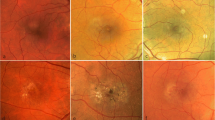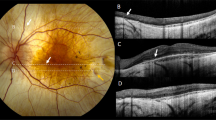Abstract
Purpose
To investigate the prevalence and features of cystoid spaces (CS) in patients with confirmed genetic diagnosis of choroideremia (CHM) using swept source optical coherence tomography (OCT).
Methods
We retrospectively reviewed CHM patients examined at the Regional Reference Center for Hereditary Retinal Degenerations at the Eye Clinic in Florence. We took into consideration genetically confirmed CHM patients with ophthalmological and swept source optical coherence tomography (OCT) examinations. The presence/absence and location of cystoid spaces in the retina of each eye were reported.
Results
A total of 42 eyes of 21 CHM patients were included in our series. The average age of the patients was 36.5 ± 20.1 (range, 13–73 years). The average best-corrected visual acuity (BCVA) for all patients was 0.63 ± 1.00 logMar (range, 0–2,80). CS were present in 15 eyes of eight patients (8/21, 38%). In all cases, CS were located in inner nuclear layer (INL); in five eyes of three patients, CS were detected also in ganglion cell layer (GCL). CS appeared as microcistoyd abnormalities and were detected in retinal areas characterized by retinal pigment epithelium (RPE) and outer retinal layers atrophy at the transition zone.
Conclusions
Cystoid spaces in choroideremia showed peculiar features; they are clusters of small-size extrafoveal degenerative cysts mainly located in inner nuclear layer at the transition zone where outer retinal layers and RPE are severely damaged.



Similar content being viewed by others
References
Coussa RG, Traboulsi EI (2012) Choroideremia: a review of general findings and pathogenesis. Ophthalmic Genet 33(2):57–65
Cremers F, Uniuersitéitszugenklinik EKU (1997) Molecular basis of choroideremia (CHM): mutations involving the Rab escort protein 1 (REP-1) gene. Hum Mutat 9:110–117
Khan KN, Islam F, Moore AT, Michaelides M (2016) Clinical and genetic features of choroideremia in childhood. Ophthalmology. 123(10):2158–2165
Aleman TS, Han G, Serrano LW et al (2017) Natural history of the central structural abnormalities in choroideremia: a prospective cross-sectional study. Ophthalmology 124(3):359–373
Jacobson SG, Cideciyan AV, Sumaroka A et al (2006) Remodeling of the human retina in choroideremia: rab escort protein 1 (REP-1) mutations. Invest Ophthalmol Vis Sci 47(9):4113–4120
Heon E, Alabduljalil T, McGuigan DB III et al (2016) Visual function and central retinal structure in choroideremia. Invest Ophthalmol Vis Sci 57(9):OCT377–OCT387
Tranos PG, Wickremasinghe SS, Stangos NT, Topouzis F, Tsinopoulos I, Pavesio CE (2004) Macular edema. Surv Ophthalmol 49(5):470–490 Review
Genead MA, Fishman GA (2011) Cystic macular oedema on spectral-domain optical coherence tomography in choroideremia patients without cystic changes on fundus examination. Eye (Lond) 25(1):84–90
Genead MA, McAnany JJ, Fishman GA (2012) Topical dorzolamide for treatment of cystoid macular edema in patients with choroideremia. Retina 32(4):826–833
Mitsios A, Dubis AM, Moosajee M (2018) Choroideremia: from genetic and clinical phenotyping to gene therapy and future treatments. Ther Adv Ophthalmol 10:2515841418817490. https://doi.org/10.1177/2515841418817490 eCollection 2018 Jan-Dec. Review
Bowne SJ, Humphries MM, Sullivan LS, Kenna PF, Tam LC, Kiang AS, Campbell M, Weinstock GM, Koboldt DC, Ding L, Fulton RS, Sodergren EJ, Allman D, Millington-Ward S, Palfi A, McKee A, Blanton SH, Slifer S, Konidari I, Farrar GJ, Daiger SP, Humphries P (2011) A dominant mutation in RPE65 identified by whole-exome sequencing causes retinitis pigmentosa with choroidal involvement. Eur J Hum Genet 19(10):1074–1081
O'Neil E, Serrano L, Scoles D, Cunningham KE, Han G, Chiang J, Bennett J, Aleman TS (2019) Detailed retinal phenotype of Boucher-Neuhäuser syndrome associated with mutations in PNPLA6 mimicking choroideremia. Ophthalmic Genet 28:1–9
Esposito G, De Falco F, Tinto N, Testa F, Vitagliano L, Tandurella IC, Iannone L, Rossi S, Rinaldi E, Simonelli F, Zagari A, Salvatore F (2011) Comprehensive mutation analysis (20 families) of the choroideremia gene reveals a missense variant that prevents the binding of REP1 with Rab geranylgeranyl transferase. Hum Mutat 32(12):1460–1469
van den Hurk JA, van de Pol DJ, Wissinger B, van Driel MA, Hoefsloot LH, de Wijs IJ, van den Born LI, Heckenlively JR, Brunner HG, Zrenner E, Ropers HH, Cremers FP (2003) Novel types of mutation in the choroideremia (CHM) gene: a full-length L1 insertion and an intronic mutation activating a cryptic exon. Hum Genet 113(3):268–275
Murro V, Mucciolo DP, Passerini I, Palchetti S, Sodi A, Virgili G, Rizzo S (2017) Retinal dystrophy and subretinal drusenoid deposits in female choroideremia carriers. Graefes Arch Clin Exp Ophthalmol 255(11):2099–2111
van Bokhoven H, van den Hurk JA, Bogerd L, Philippe C, Gilgenkrantz S, de Jong P, Ropers HH, Cremers FP (1994) Cloning and characterization of the human choroideremia gene. Hum Mol Genet 3(7):1041–1046
McTaggart KE, Tran M, Mah DY, Lai SW, Nesslinger NJ, MacDonald IM (2002) Mutational analysis of patients with the diagnosis of choroideremia. Hum Mutat 20(3):189–196
Garcia-Hoyos M, Lorda-Sanchez I, Gómez-Garre P, Villaverde C, Cantalapiedra D, Bustamante A, Diego-Alvarez D, Vallespin E, Gallego-Merlo J, Trujillo MJ, Ramos C, Ayuso C (2008) New type of mutations in three spanish families with choroideremia. Invest Ophthalmol Vis Sci 49(4):1315–1321
Salvatore S, Fishman GA, Genead MA (2013) Treatment of cystic macular lesions in hereditary retinal dystrophies. Surv Ophthalmol 58(6):560–584. https://doi.org/10.1016/j.survophthal.2012.11.006 Review
Rodrigues MM, Ballintine EJ, Wiggert BN, Lee L, Fletcher RT, Chader GJ (1984) Choroideremia: a clinical, electron microscopic, and biochemical report. Ophthalmology. 91(7):873–883
Xue K, Oldani M, Jolly JK, Edwards TL, Groppe M, Downes SM, MacLaren RE (2016) Correlation of optical coherence tomography and autofluorescence in the outer retina and choroid of patients with choroideremia. Invest Ophthalmol Vis Sci 57(8):3674–3684
Makiyama Y, Oishi A, Otani A, Ogino K, Nakagawa S, Kurimoto M, Yoshimura N (2014) Prevalence and spatial distribution of cystoid spaces in retinitis pigmentosa: investigation with spectral domain optical coherence tomography. Retina 34(5):981–988
Murro V, Mucciolo DP, Sodi A, Passerini I, Giorgio D, Virgili G, Rizzo S (2019) Novel clinical findings in autosomal recessive NR2E3-related retinal dystrophy. Graefes Arch Clin Exp Ophthalmol 257(1):9–22
Sergouniotis PI, Davidson AE, Lenassi E, Devery SR, Moore AT, Webster AR (2012) Retinal structure, function, and molecular pathologic features in gyrate atrophy. Ophthalmology 119(3):596–605
Strong SA, Hirji N, Quartilho A, Kalitzeos A, Michaelides M (2019) Retrospective cohort study exploring whether an association exists between spatial distribution of cystoid spaces in cystoid macular oedema secondary to retinitis pigmentosa and response to treatment with carbonic anhydrase inhibitors. Br J Ophthalmol 103(2):233–237
Dysli M, Rückert R, Munk MR (2019) Differentiation of underlying pathologies of macular edema using spectral domain optical coherence tomography (SD-OCT). Ocul Immunol Inflamm 27(3):474–483
Bringmann A, Pannicke T, Grosche J et al (2006) Muller cells in the healthy and diseased retina. Prog Retin Eye Res 25:397–424
Reichenbach A, Wurm A, Pannicke T, Iandiev I, Wiedemann P, Bringmann A (2007) Muller cells as players in retinal degeneration and edema. Graefes Arch Clin Exp Ophthalmol 245:627–636
Zinkernagel MS, Groppe M, MacLaren RE (2013) Macular hole surgery in patients with end-stage choroideremia. Ophthalmology. 120(8):1592–1596
Shinoda H, Koto T, Fujiki K, Murakami A, Tsubota K, Ozawa Y (2011) Clinical findings in a choroideremia patient who underwent vitrectomy for retinal detachment associated with macular hole. Jpn J Ophthalmol 55(2):169–171
Simunovic MP, Jolly JK, Xue K et al (2016) The spectrum of CHM gene mutations in choroideremia and their relationship to clinical phenotype. Invest Ophthalmol Vis Sci 57:6033–6039
Financial disclosure
This research was partially supported by Minister of Health and Tuscany Region (Project NET-2016-02363765).
Author information
Authors and Affiliations
Corresponding author
Ethics declarations
All procedures performed in studies involving human participants were in accordance with the ethical standards of the institutional and/or national research committee and with the 1964 Helsinki declaration and its later amendments or comparable ethical standards.
Conflict of interest
The authors declare that they have no conflict of interest.
Informed consent
Informed consent was obtained from all individual participants included in the study.
Additional information
Publisher’s note
Springer Nature remains neutral with regard to jurisdictional claims in published maps and institutional affiliations.
Rights and permissions
About this article
Cite this article
Murro, V., Mucciolo, D.P., Giorgio, D. et al. Optical coherence tomography (OCT) features of cystoid spaces in choroideremia (CHM). Graefes Arch Clin Exp Ophthalmol 257, 2655–2663 (2019). https://doi.org/10.1007/s00417-019-04508-7
Received:
Revised:
Accepted:
Published:
Issue Date:
DOI: https://doi.org/10.1007/s00417-019-04508-7




